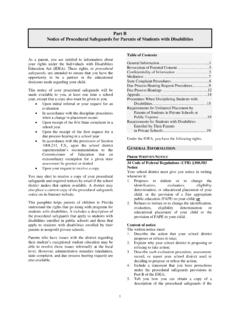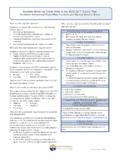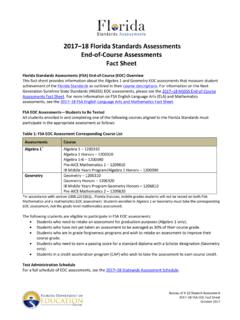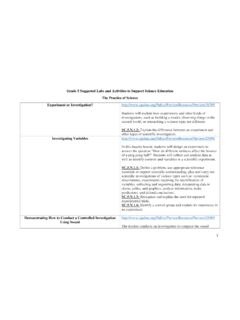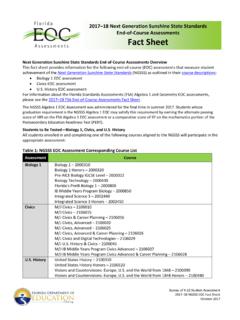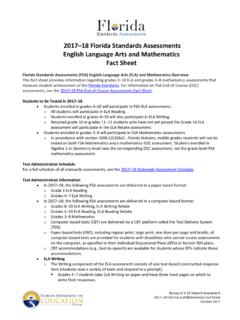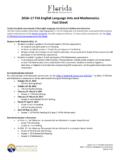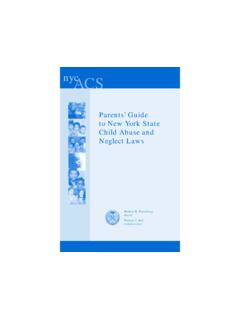Transcription of Module D: Lesson Plan 12: Goal Setting and Decision-Making ...
1 Module D: Lesson Plan 12: Goal Setting and Decision-Making Topic: Informed Decision-Making Standard(s): Students will: Identify and demonstrate processes for making short and long term goals. Demonstrate employability skills such as working in a group, problem-solving and organizational skills, and the importance of entrepreneurship. Length: Two class periods Objective: The student will recognize the importance of seeking information before making a decision. Materials: Red, white and blue poker chips Clear plastic bag Chart paper and markers Decision-Making Scenarios Sheet Handout Decision-Making Points to Remember Description of Activity: A.
2 Poker Chip Activity Show student a clear plastic bag filled with red, blue, and white poker chips. Ask for two volunteers to participate in the demonstration. Explain the rules: Participant may use only one hand. (Bag will be held open for student) In 60 seconds the student will take out as many poker chips as possible. After the first participant completes his/her turn, change the information slightly. I forgot to mention that the white chips are worth $10; the red $50; and blue $100. After participant number two completes his/her turn, sort and add chips.
3 Record on board. Have students multiply their total in dollars. Participant number two will have the largest amount in dollars, however not necessarily the largest number of chips. Discuss how a little knowledge about adecision can alter how one approaches a situation and how it can improve the outcome. Relate to career goals. B. Steps to Decision-Making 1. Seven Steps to Decision-Making 1. Define your problem 2. Gather information and resources 3. List options 4. Weigh and compare options 5. Make a decision 6.
4 Make a plan of action 7. Evaluate the decision 2. Discuss the types of decisions and the seven-step process to Decision-Making . Decision-Making starts with vision. In order to set career and personal goals, take some time to think about the knowledge you have of yourself and visualize what you want your life to look like. 3. Think about where you would like to live. Would moving to another city or even a state be an option? Do you want a family? What kind of work would you like? What would you do for leisure? What kind of lifestyle would you want?
5 The process of answering these questions can help you to develop your own personal vision. Once you have that vision, you have the raw materials than can be turned into short-term and long-term goals. The steps to making a decision can help you with many types of career-related decisions. You can use the steps to determine: Which occupation field/cluster to enter Which training/educational program to take Whether you would like to own your own business Deciding on a part time job while in high school Whether or not you want to go directly to work or college immediately after high school Which high school courses to take Whether to change jobs Knowing what you want from life will help you to set.
6 Career objectives Personal objectives Community objectives Lifelong learning objectives Goals Start with the big picture and then consider how your objectives will help you reach your vision. You can then makes decisions and plan short and long-term goals. 4. Group students into four teams. Give each team one of the Decision-Making scenarios. Each team will use the seven-step Decision-Making process to work through their designated Decision-Making scenario. 5. Each group will illustrate their decision and its outcome on a sheet of chart paper.
7 6. Each group will present their decision and results to the class. 7. Brainstorm as a class and record on the board: Kinds of information needed to make a decision about educational choices Kinds of information needed to make a decision about career choices 8. Each student will identify a problem and work through the seven-step Decision-Making process. Evaluation: Students will use the seven steps of Decision-Making to make a decision. Decision-Making Points to Remember Student Handout 1. You can always change your mind about a decision you ve made.
8 2. There is probably no one right choice; and few decisions are totally wrong. 3. Deciding is a process, not a static, one-time event. We are constantly re-evaluating in light of new information. A decision may not have had the consequences you expected soyou can start the process over again. 4. When it comes to a career decision, remember you are not choosing for a lifetime; in allprobability, you will have several jobs during your working life. Choose for now and don t worry whether you ll enjoy it 20 years from now. The workplace is constantly changingand you will need to change with it.
9 5. There s a big difference between decision and outcome. You can make a good decisionbased on the information at hand and still have a bad outcome. The decision is within your control, but the outcome is not. All decisions have the element of chance or risk. 6. Think of the worst outcome. Could you live with that? If you could live with the worst,then anything else does not seem that bad. 7. Indecision is a decision not to decide. There are probably risks involved in not deciding, in not taking action. 8. Try to avoid either/or thinking; usually there are more than two options.
10 Be imaginative and creative. 9. You may want to consult others for information but eventually you must make up your own mind. Sometimes it may be a good idea to consult more than one source so that yourinformation is not biased. 10. Listen to your inner voice; trust your intuition. What feels right? If you are making a decision that can have long time consequences, take your time. Don t rush and make an impulsive decision. Decision-Making Scenarios Scenario 1 Football season starts this weekend and Steve is excited about his school s first game.
